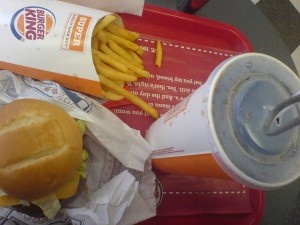In her study, "The Role of Local Food Availability in Explaining Obesity Risk among Young School-Aged Children," Lee then turned to obesity rates among children. "That was the second question," she said. "Does what families have access to, does it even matter for explaining who becomes obese over time and who doesn't? ... It has no relation to obesity outcomes."
As a researcher, Lee believes it's time to reflect on policies that focus on grocery stores. "We all like a silver bullet," she told me, "but this is not it."
A second study from the Rand Corporation reinforces Lee's findings. The study could not find a "robust relationship between food environment and consumption." Co-author Roland Sturm cautioned there were limitations of the study, but nonetheless added, "I never bought into the 'supermarkets make you thinner' story."
Part of the problem is what happens when an individual enters a supermarket. "I challenge you to go to a grocery store and walk around and for every healthy food you can find, you can find an unhealthy counterpart," Lee says. "For everything you can think of. There's whole milk and fat free milk. You can buy fresh broccoli or broccoli with cheese sauce in the frozen food aisle."
But as a sociologist, Lee did not want her research to be taken as fodder to "blame the individual." People's social situation drives health. "These things we know," she says, "Education, economic mobility, they are so predictive of your health. ... At the end of the day what drives obesity is choices we make, shaped by our environment."
That environment still has to do with what's actually in a grocery store, insist some advocates. Hannah Burton Laurison is with Public Health Law and Policy. While she says she agrees that access to grocery stores with fresh foods may not help to alleviate childhood obesity, she says the issue of food outlet availability is much more nuanced than 'is there a supermarket in the neighborhood?' "We're trying to understand a complicated food retail environment where there are good options available and unhealthy options available, but pricing and quality and marketing are huge factors in how we make decisions," she said. "You have to have access. It is not a single solution and I would agree with that finding in each of these studies, but you do have to have access, ... access to healthy foods matters quite a lot."
Laurison points to a specific example in San Francisco's Bayview Hunters Point, a largely poor and minority neighborhood in San Francisco, with few grocery stores. In 1998, when the current owner purchased the store, alcohol sales accounted for 55 percent of revenue and and produce was less than two percent. In other words, more of a liquor store than a grocery store. Over the next 12 years, a community group worked with the store to improve the variety and quality of its produce. The store more than doubled its gross revenue. By 2010 produce sales were 17 percent of revenue and alcohol sales were down to 14 percent of revenue.
It would be hard for anyone to disagree that the improvement of this store's produce offerings is not worthwhile. But a healthier diet does not necessarily affect obesity. "How can we improve diet to become healthier AND lose weight?" Sturm muses. "It's not necessarily the same thing. You can have a really good diet in many ways, but still be heavy."
A key component of the Let's Move! campaign was the establishment of the White House Childhood Obesity Task Force. The Task Force explicitly promotes supermarkets and based its recommendation on a single study that found an association between supermarkets in a ZIP code and lower body weight among adolescents. But, as Sturm details in his study, the Task Force did not cite two other studies (here and here) that found no connection.
